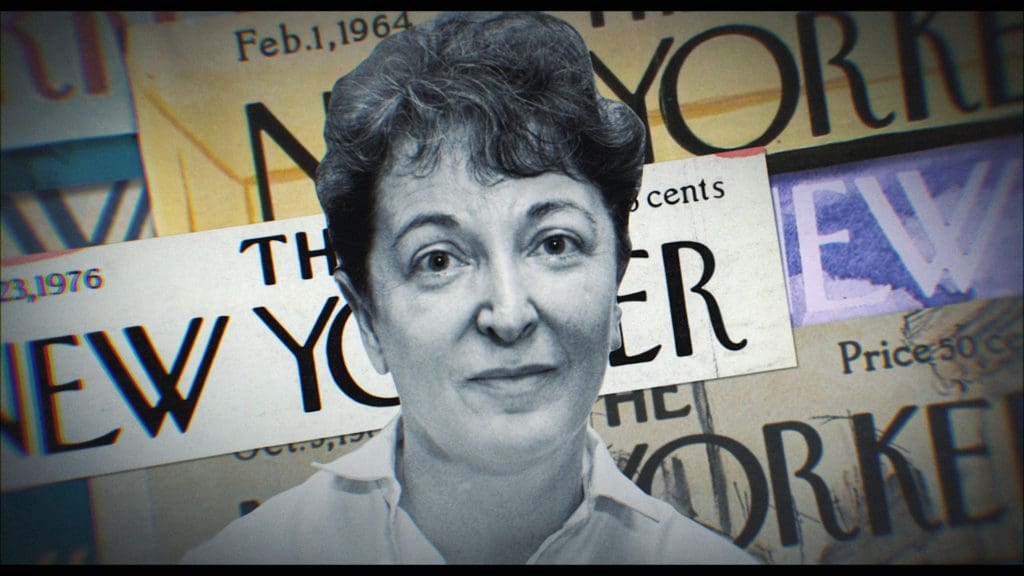
It is almost impossible to overstate Pauline Kael’s influence on film criticism. A regular critic at The New Yorker from her 1967 debut reviewing director Arthur Penn’s Bonnie and Clyde, to her retirement in 1991, she shaped not just the way we talk about films, but American filmmaking itself. An early champion of directors like Spielberg, Scorsese and DePalma, she helped foster the American New Wave, becoming so influential that with a single review, she could make or break a career. The new documentary from writer-director-editor Rob Garver, What She Said: The Art of Pauline Kael, offers an informative and compelling view of Kael’s career that nonetheless feels like it’s missing something.
Garver’s first task is to familiarize an audience that may not know how Kael became such a cultural touchstone by tracing the trajectory of her career and he does so in a way that’s both informative and engaging. Using interviews with her daughter Gina James, other critics (like David Edelstein and Stephanie Zacharek), filmmakers (like David O. Russell in a new interview and Norman Mailer in archival footage) and clips from the films she reviewed (2001: A Space Odyssey, Carrie and a host of others), Garver often makes the admittedly outlandish turns in Kael’s career feel like something out of the movies.
There’s the anecdote about how she got her first review published, in which she was criticizing Charlie Chaplin’s Limelight in a restaurant with a group of friends after a screening and someone from the City Lights Bookstores Journal asked her to write a review for them based on what they overheard. Or there’s the scene where Sarah Jessica Parker reads out Kael’s devastating review of Hiroshima, Mon Amour as images from the film play under it, her lines about the opening shots of lovers entwined while ash falls on them only outdone by her declaration that, “I thought its 88 minutes lasted forever.”
Perhaps inevitably, Garver’s strongest argument for the power of Kael’s work, though, comes during the discussion of 1967’s Bonnie and Clyde. Initially dismissed by the rest of the critics, Kael’s positive review, which she said properly electrified an audience numbed to violence by years of Vietnam War footage, changed not only the film’s fate, but the course of Hollywood filmmaking. Watching the movie’s violent final scene as Kael’s words play on the soundtrack, you can feel your perspective shifting forever and it’s easy to understand how Kael became such an influential voice.
While Garver focuses a lot of attention on the positive effects Kael’s reviews could have on films and their directors, he’s also equally willing to show how devastating her power could be. One of the film’s most remarkable sequences relays an infamous New York Film Critics Circle party where she berated director David Lean. In an archival interview, we watch Lean struggle with the memory–clearly still stung by whatever she said–saying that her criticisms that night actually kept him from making films for a time afterward. Seeing his quiet and wounded expression in that footage, it’s clear how cutting her words must have been and while the What She Said sets the viewer up to admire that candor, it also makes the moments where the film holds back stand out.
Perhaps the most relevant moment is the section when Garver relays that not only was Kael an early champion of Woody Allen’s work, but they also shared a friendship (or at least a friendly mutual regard). Watching them gush over each other in a simultaneous television interview, it’s natural to wonder how Kael’s perception of the director might have changed when his adoptive daughter, Dylan Farrow, accused him of assault in 1992. Granted, Kael had retired from regular criticism by then, but she did keep writing and by not at hinting at that tough subject, Garver’s film can feel a little too admiring and as a result, incomplete. Rather, the closest Garver comes to really criticising Kael is a brief discussion of Renata Adler’s review of Kael’s When the Lights Go Down in the New York Review of Books that’s quoted but quickly dismissed as a largely baseless hit-piece.
Watching What She Said: The Art of Pauline Kael, it’s hard not to wonder what the critic herself would think about the film of her work. Would she think it was a fair representation of her influence? Would she feel embarrassed watching the David Lean interview? Would she wish it got a bit more personal? Hell, knowing her penchant for going against the critical grain, maybe she’d even pan it. It’s impossible to know. The only sure thing is that her take would be thought-provoking and if nothing else, Garver’s film is equally challenging, forcing viewers not just to contemplate Kael’s influence, but the role of criticism in shaping culture.

